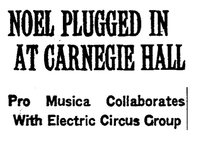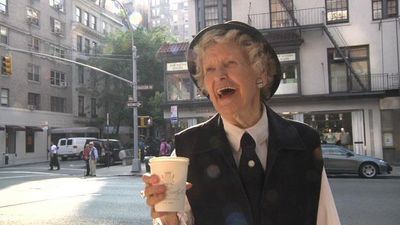Alex Ross's Blog, page 173
April 24, 2013
Miscellany: The end of New York City, etc.
Ellen Rosand's Yale Baroque Opera Project, which has brought one revelation after another, arrives on more familiar ground with a production of Cavalli's La Calisto. Performances are on May 4 and 5; if you go on the 4th, you can also catch Yale Opera's Iolanta.... There's an edifying Tumblr devoted to the multimedia production of HPSCHD, coming up at ISSUE Project Room / Eyebeam. Go here for more about the Electric Circus and, even farther out, Cerebrum.... Recommended: Sean Shepherd's opulent new score Tuolumne, after three photographs by Ansel Adams. The Cleveland Orchestra just gave the premiere; the score is online here.... CUNY will present a lecture by the very distinguished critic and author Paul Griffiths on May 10. Music of Rebecca Saunders, whom I write about this week, will be heard alongside him.... Opportunity Music Project supports free music lessons for kids.... I hugely enjoyed the new documentary Elaine Stritch: Shoot Me, which played at the Tribeca Film Festival. At the screening yesterday, her music director, Rob Bowman, indicated that the astounding Ms. Stritch will leave New York tomorrow, after seven decades in the city. We cannot drink to that.
April 23, 2013
Burr Van Nostrand
New World Records has an important new release devoted to the music of Burr Van Nostrand, a California-born avant-gardist who was heavily immersed in the anti-war movement of the nineteen sixties and seventies. Above is a live performance of Van Nostrand's Voyage in a White Building I, a wildly fractured setting of the first part of Hart Crane's poetic cycle Voyages; it derives from the same New England Conservatory concert that is preserved on the New World disc. (Matthew Guerrieri was there for NewMusicBox.) The spellbinding vocalist is Lautaro Mantilla, dressed as a newscaster reporting the end of days.
April 21, 2013
Gender parity and new music
Electric Circus, Electric Ear
 Tonight's episode of Mad Men featured a brief scene at the
Tonight's episode of Mad Men featured a brief scene at the
Electric Circus, one of the leading New York clubs of the late sixties. I gathered some material about the Circus for a talk a couple of years ago. It operated
in the former Polish National Home on St. Mark’s Place, in a building that now
houses a Chipotle. From the outset, the Electric Circus featured contemporary classical
composers on its musical menu. The connection made intellectual sense, given
the link between early West Coast psychedelia and the San Francisco Tape Music
Center. Indeed, on the opening night of the Electric Circus, Morton Subotnick,
co-founder of the Tape Music Center, presented a version of his electronic
piece Silver Apples of the Moon. In an
interview with the scholar Robert J. Gluck, Subotnick recalled “Seiji Ozawa
and the Kennedys . . . dancing to
it in tuxedos, under strobe lights.” Alas, no photographs of this
spectacle have surfaced. On Monday nights, Subotnick curated an explicitly
classical series called the Electric Ear, which at one time or another hosted John Cage,
Mel Powell, Alvin Lucier, David Behrman, Pauline Oliveros, Terry Riley,
Salvatore Martirano, Robert Ashley, and David Rosenboom.
In
December, 1967, the Electric Circus took over Carnegie Hall and hosted an
Electric Christmas, involving Circus Maximus, the club’s house band; electronic
music by Subotnick; a light show by Anthony Martin; and, I kid you not, the
pioneering early-music ensemble New York Pro Musica. The notion of inviting New
York Pro Musica seems to have originated with Edgar Coons, a New York
University psychology professor who had earlier studied composition with Roy
Harris and Virgil Thomson. One night he had wandered into the Electric Circus and,
as he later recounted in an article for the Music
Journal, “experienced a psychedelic light and rock show that ‘blew my
mind.’” For reasons he leaves a bit vague, Coons was reminded of medieval
French music in the New York Pro Musica repertory, and reached out to the
parties involved. Carnegie became interested, and two Christmas shows were
arranged. Harold Schonberg, the chief critic of the New York Times, reported that New York Pro Musica at one point were
seen performing beneath a gigantic filmed projection of a fish opening and
closing its mouth—a Northern pike or a muskie, Schonberg guessed. Later, Circus
Maximus and New York Pro Musica collaborated on a rendition of Machaut’s “Douce
Dame Jolie.” A follow-up Electric Easter concert featured the soul group the Chambers
Brothers performing Perusio’s “Le grant désir” and New York Pro Musica singing
“Allo adieu,” the Beatles hit of early 1968.
The
press reception was instructive. One might have expected Schonberg, a critic militantly
opposed to the avant-garde, to have mocked the affair mercilessly. But he professed
to have enjoyed himself. He was impressed that the hall had sold out and also that the audience was
“overwhelmingly young.” Time magazine,
too, voiced its approval, describing the Machaut mashup as “delightful.” For
these observers, the Electric Circus was fostering a new kind of avant-garde,
one that overcame the esoteric tendencies of post-World War II music. In a
think piece for the Times, Schonberg
wrote, “I had the nagging notion that here was the music, the art form, the Gesamtkunstwerk of the future.” Richard Goldstein,
surveying the scene from the rock side, reached a similar conclusion. “We need
to have great art that is accessible,” Goldstein wrote in New York magazine. The Beatles, Zappa, and other rock innovators, Goldstein
said, “know something which John Cage has forgotten. Art is what you do to
other people, not to yourself. ... There is no longer any need for alienation
in the avant-garde.” The point is debatable; the Electric Circus is long gone, Cage is resurgent, and the alienated avant-garde still has a few things to say.
April 18, 2013
For Dean Drummond
The composer, musician, and preservationist, keeper of the magnificent Harry Partch instrumentarium, died last Saturday, at the age of sixty-four. In 2005, I had the great experience of hearing Drummond's group Newband play Partch's Oedipus Rex at Montclair State, the current home of the Harry Partch Institute; the university's Peak Performances series will present a memorial concert on April 24.
April 16, 2013
Miscellany: Eleanor Roosevelt plays Elvis, etc.
Andrew Patner and Anastasia Tsioulcas celebrate Adolph "Bud" Herseth, the awe-inspiring, epoch-making Chicago Symphony trumpeter, who died last weekend at the age of ninety-one.... Congratulations to Caroline Shaw, who has won the 2013 Pulitzer Prize for Music for her work Partita. You can listen at her website, and buy a recording at New Amsterdam.... President Obama's 2014 budget contains some good news for the arts — modest increases in the budgets of the National Endowment for the Arts and the National Endowment for the Humanities — but a proposed limit on tax deductions for charitable giving could have a devastating effect on arts institutions, not to mention higher education, medical research, and much else.... Charpentier's David et Jonathas comes to BAM this week, with William Christie presiding. Parterre has a preview.... There's a new documentary about Maurice Martenot, inventor of the ondes Martnenot. It shows at NYU on April 24.... Speaking of the NEH, it has funded a digitization project for the wondrous archives of WNYC. Among the treasures: a discussion of American music with Copland, Bernstein, Lukas Foss, and Irving Fine; a 1952 Lewisohn Stadium concert with Marian Anderson singing Monteverdi's Lamento d'Arianna, a zesty Rosenkavalier Suite with Mitropoulos conducting, and airplanes flying overhead; and a March of Dimes fundraiser at which Eleanor Roosevelt plays disc jockey, spinning Elvis Presley at the request of kids with polio ("Oh, you all like the same person, don't you?").... Lisa Bielawa's years-in-the-making Tempelhof Broadcast project will reach fruition in May. A video foretaste is here.
April 14, 2013
For Colin Davis
It continues here. The ever-questing, deep-thinking, profoundly musical English conductor died today at the age of eighty-five. Of many brilliant concerts, three are burned most strongly in my mind: his 2011 Missa Solemnis at Carnegie Hall, which seemed already to be emanating from the next world; his 2004 Peter Grimes, with a storm of unbelievable fury; and his 2004 rendition of Britten's Phaedra with the New York Philharmonic, in which Lorraine Hunt Lieberson gave what may have been her most uncanny performance, no doubt emboldened by the granitic solidity of the sound behind her. Like Charles Mackerras, Davis led music in such a way that it simply sounded right, in the rhythm of the heart.
April 7, 2013
Tenebrae, Lamentations
Singing Shadows. The New Yorker, April 15, 2013.
Videos of TENET's Lamentations series are archived on Trinity Wall Street's website; here is the Buxtehude Membra Jesu Nostri. TENET's website gives details of upcoming performances, including a Bach Mass in B Minor at Grace Church in May. Trinity's festival of the sacred works of Stravinsky takes place on April 26-28; this will be the first New York performance of Threni in many years. Coming to Trinity in the fall is a sprawling survey of the music of Benjamin Britten, mostly in the form of weekly lunchtime concerts. Details are yet to be announced, but expect to hear a great many Britten works seldom performed in these parts.
Tchaikovsky, Ruggles
On the left, Ross Braught's Tchaikovsky's Sixth (1935); on the right, The Sun Treader, Thomas Hart Benton's marvelous 1934 portrait of Carl Ruggles. At the Nelson-Atkins Museum, Kansas City, Missouri.
Alex Ross's Blog
- Alex Ross's profile
- 425 followers





